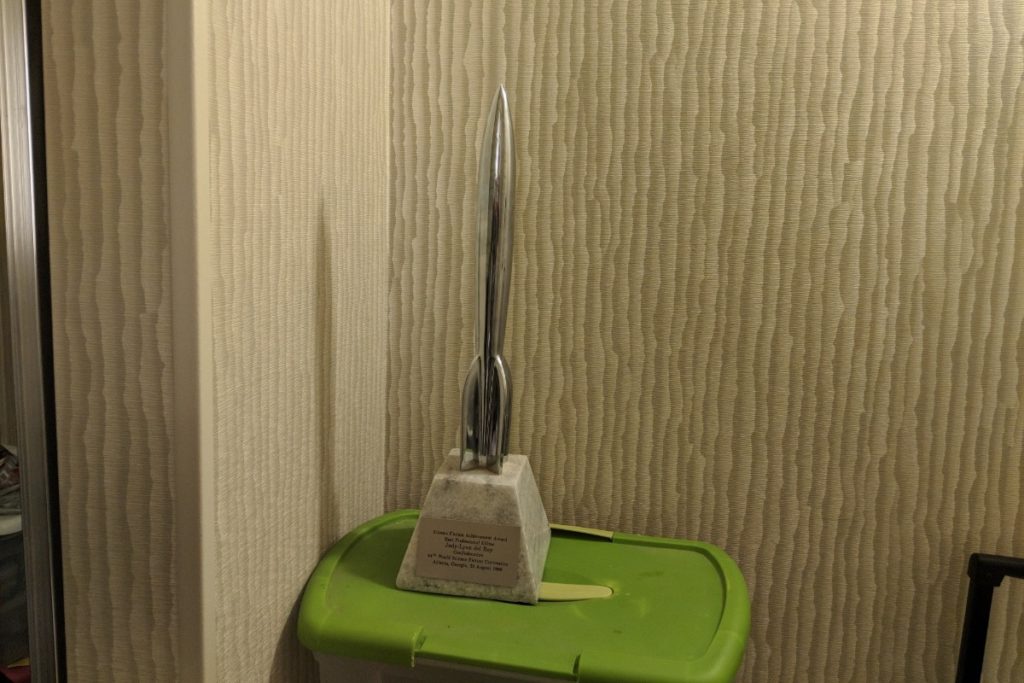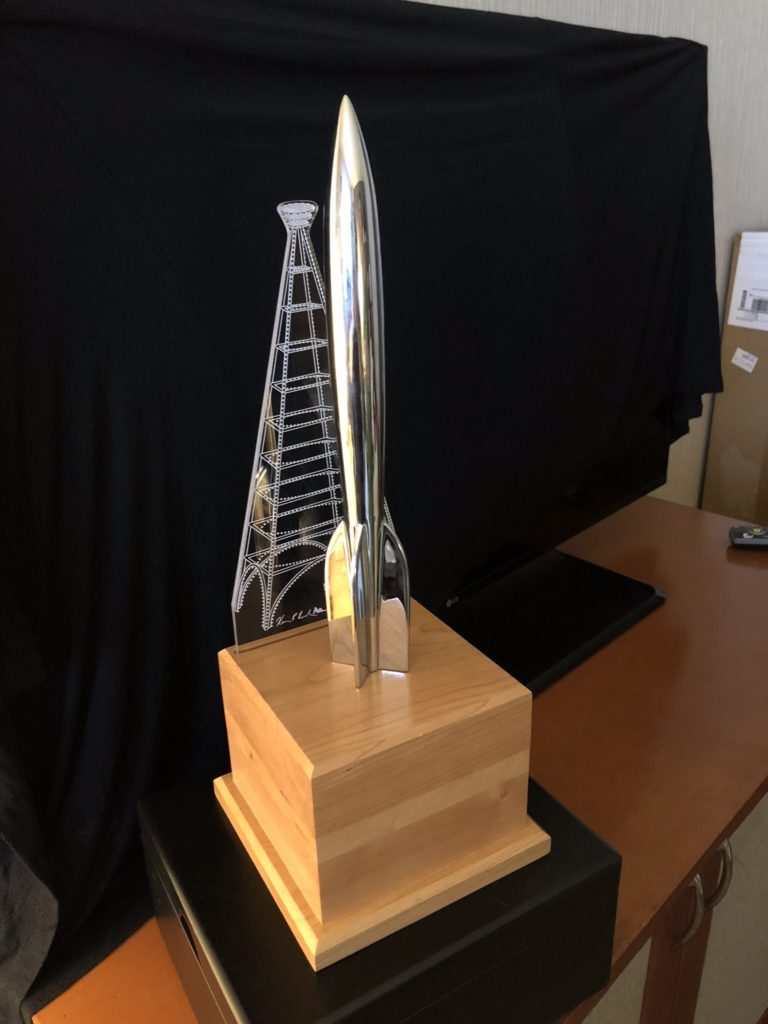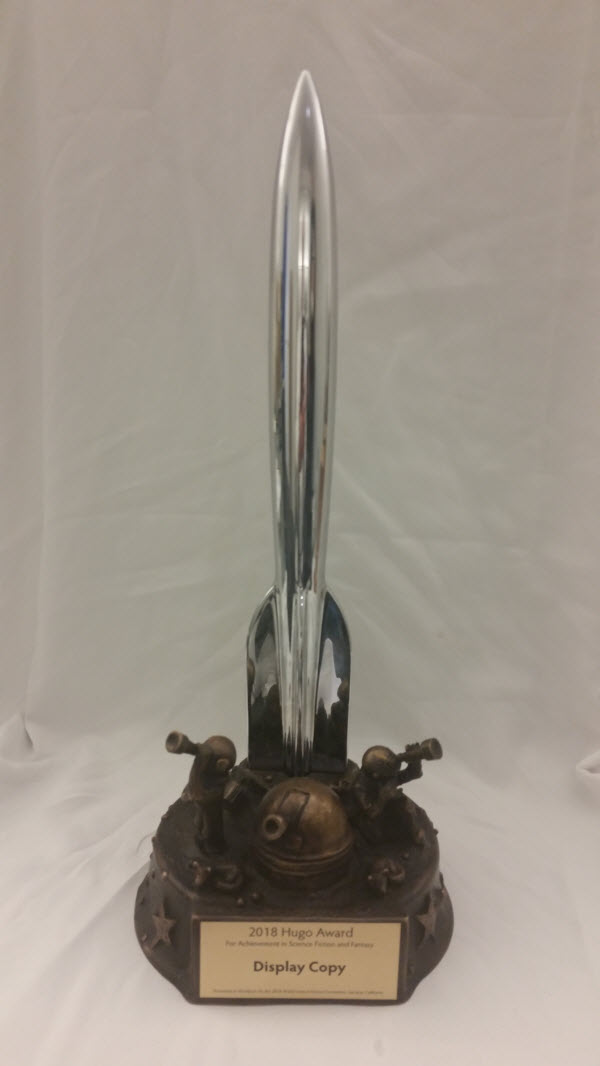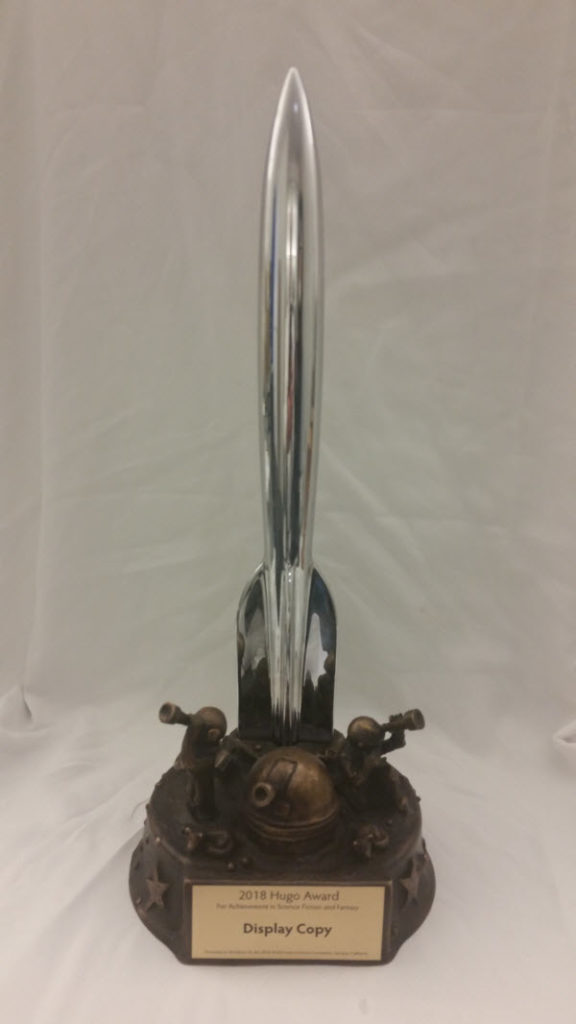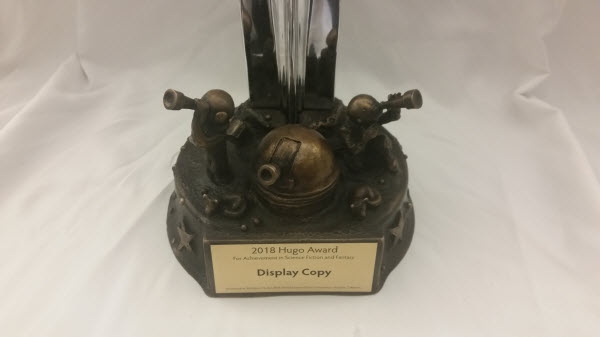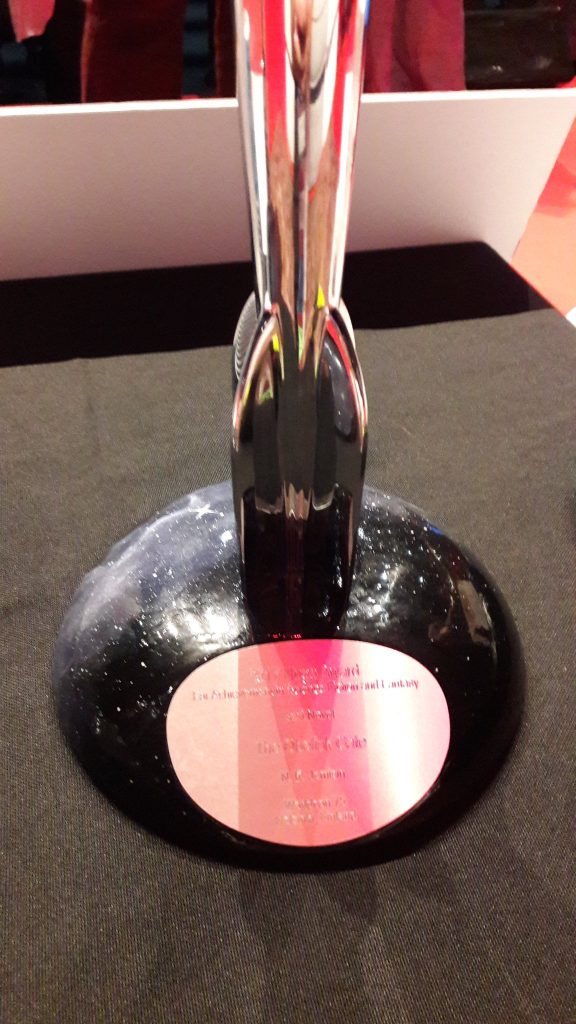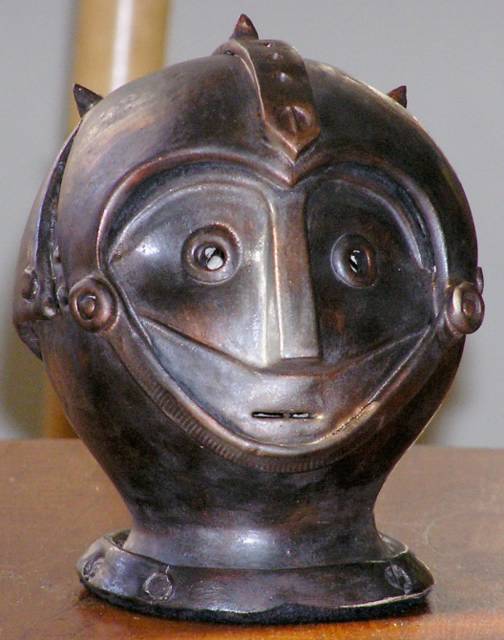(1) WHO TO LISTEN TO. Nicholas Whyte enthusiastically reviews four audio Doctor Who stories in “Jenny – the Doctor’s Daughter”.
Big Finish have scored a major coup by persuading Georgia Tennant to return to her brief role as Jenny, the Tenth Doctor’s cloned daughter, for more sfnal adventures across space and time, flanked by Sean Biggerstaff as the innocent but mysterious Noah, and both pursued by Siân Philips (who was Livia in I, Claudius forty years ago) as a vengeful cyborg, the Colt-5000. (Georgia Moffatt, as she then was, had a part in a Big Finish audio back in 2000, when she was only 16.)
(2) EVERMORE. Utah’s VR theme park Evermore opens today: “Evermore Park immersive experience from former Disney Imagineer invites you to enter fantasy world”.
Walt Disney Imagineers work diligently to create the most incredible experiences in the world. Sometimes, however, they take their immeasurable talents and create these experiences elsewhere. That’s the case for former Imagineer Josh Shipley.
According to his LinkedIn page, Shipley started with the Walt Disney Company in 1992 and became an Imagineer in 1996. He left Disney Imagineering in 2017 and began working on an immersive new experience park (located in Pleasant Grove, Utah) known as Evermore.
(3) ALL YOUR BASE. The Hugo Awards official site now has some very nice photos of the 2018 Hugo Award base created by Sara Felix and Vincent Villafranca, including closeups of the figures, inscriptions, and other details.
(4) STILL TIME TO HELP. A GoFundMe created to help Samanda Jeude is still open for donations. It’s received only a little over $1,000 so far. One of the incentives was a 1986 Hugo Award trophy.
“Helping The Helper -Electrical Eggs” —
Science Fiction Fandom lost a long time friend and organizer in January, in the form of Donald (Dea) Cook. He left behind another well-known fan, his wife of over 30 years, Samanda Jeude. Samanda is best known for establishing the organization Electrical Eggs, the first Disability Access organization in the Science Fiction community. Don was Sam’s sole career. She had polio as an infant, and that was complicated later in life by a couple of strokes. She now resides in a nursing home in Canton, Georgia. We helped to clear out the house to get it sold, and are now selling all of the contents to pay for Samanda’s ongoing care needs. How does any of this involve a Hugo, you might ask, and rightfully so!
Marcia Kelly Illingworth organized the appeal, and says the Hugo will stay in the fannish family, so to speak:
Update #2
The votes are in! The people have spoken! You have voted overwhelmingly to donate the Hugo to Fandom. I think I always knew that you would. Samanda thanks you, and I thank you!
We are leaving the fund open for a while longer for those who still wanted the opportunity to donate. Thank you again for all of your support.
Since donors have voted to donate the Hugo to fandom rather than have it be auctioned off to the highest bidder, that means less money raised for Samanda’s ongoing care. Given her service to fandom, it would be great to see further donations from fans.
(5) HIS PREFERRED WINNER. Nicholas Whyte has one thing in common with all Hugo voters – he thinks sometimes the wrong book loses — in this case, “Snow Crash, by Neal Stephenson”.
Second paragraph of third chapter:
But there are worse places to live. There are much worse places right here in this U-Stor-It. Only the big units like this one have their own doors. Most of them are accessed via a communal loading dock that leads to a maze of wide corrugated-steel hallways and freight elevators. These are slum housing, 5-by-10s and 10-by-10s where Yanoama tribespersons cook beans and parboil fistfuls of coca leaves over heaps of burning lottery tickets.
This popped to the top of one of my lists just at the moment that I have been reading some of the other award winners from 1994. Snow Crash was shortlisted for the Arthur C. Clarke Award (won by Jeff Noon’s Vurt) and the BSFA Award (won by Christopher Evans’ The Aztec Century); also on both of those shortlists was Ammonite by Nicola Griffith, which won the Tiptree. The Hugo for Best Novel was shared between A Fire On The Deep and Doomsday Book, the latter winning the Nebula as well; Snow Crash was on the Hugo long-list, but nowhere for the Nebula. (It did win two awards in French translation, and one in Spanish.)
This is surely one of those cases where the awards in general (and particularly across the Atlantic) failed to spot the classic in the making: Snow Crash now has more owners on LibraryThing than any two of the other books named above combined (which is why I read it; see below). I think it’s much the best of them.
(6) YOUR DIGITAL GOOD PLACE. Courtesy of io9, (“Google Chrome Has a Forking Clever Good Place Extension”) I learned about Google Chrome’s The Good Place extension:
Replace new tab page with a personalized dashboard that brings your very own version of The Good Place right to your desktop.
Calling all Good Place fans! Make The Good Place your Chrome home with an all-new tab page that features your favorite characters, quotes and photos from the show. Complete with weather updates, calendar reminders, and daily “inspiration” from Eleanor and the crew, you can become more productive and feel like you’re getting into The Good Place every single time you go online.
FEATURES:
-Replace curse words from your Chrome with the Obscenities Censor
-Search the web using your very own Janet
-Pry yourself away from the internet with the “Joy of Missing Out” built-in break reminders
-Replace “Thumbs up” and “Thumbs down” buttons on YouTube with “Good Place” and “Bad Place”
(7) TODAY IN HISTORY
- September 8, 1966 — A little TV show, Star Trek, aired its first episode, “The Man Trap,” written by George Clayton Johnson.
And earlier this week The Hollywood Reporter reprinted the show creator’s article about his new series: “When Gene Roddenberry Explained ‘Star Trek’ in 1966”.
Just over two months after Star Trek first beamed up to audiences on NBC during the 8:30 p.m. hour on Sept. 8, 1966, creator Gene Roddenberry wrote a column explaining the scope of his ambitious space series — and why it aimed for much more “science” than “fiction.” His original column in The Hollywood Reporter, “Science Fiction Thing of Past,” is below:
Imagine a space vessel, larger than any naval vessel known, crossing our galaxy at a velocity surpassing the speed of light. Fourteen decks, a crew of over 430 persons. A whole city afloat in space.
Science fiction? Absolutely not. Rather, real adventure in tomorrow’s space. Based upon the best scientific knowledge and estimates of what our astronauts of the future may face when they move out of our own solar system and into the vastness of our galaxy. Other worlds like ours? Other peoples? What?
Our starship, designed with the help of space experts, is the United Space Ship Enterprise. The place — NBC-TV, Thursday nights. In full color, this new action-adventure format boasts flesh and blood stars like talented William Shatner playing Ship’s Captain Kirk; love Grace Lee Whitney playing Yeoman Janice Rand; and Leonard Nimoy in an unusual new role as the half-alien Mister Spock. Plus talents such as DeForest Kelley, George Takei, Jimmy Doohan and Nichelle Nichols.
(8) TODAY’S BIRTHDAYS
[Compiled by Cat Eldridge.]
- Born September 8 – John Boardman, 85. Editor, fanzine Knowable; his Diplomacy zine, Graustark turned fifty a few years ago. Active in civil rights as a student as Florida State University which got him expelled from his doctoral studies program there.
- Born September 8 – Michael Hague, 70. Illustrator of his own work including The Book of Dragons, Michael Hague’s Magical World of Unicorns, The Book of Fairies, The Book of Wizards and Michael Hague’s Read-to-Me Book of Fairy Tales; also interior and cover art for such genre works as The Hobbit, The Wizard of Oz and The Wind in The Willows.
- Born September 8 – Gordon Van Gelder, 54. Editor, The Magazine of Fantasy & Science Fiction, The New York Review of Science Fiction and a smattering of anthologies including Go Forth and Multiply and Welcome to the Greenhouse. Reviewer as well.
- Born September 8 – Matt Ruff, 53. Author of quite a number of genre novels including Fool on The Hill, Lovecraft Country which was nominated for a World Fantasy Award, and Set This House in Order: A Romance of Souls which may or may not be genre fiction but never-the-less won a James Tiptree Jr. Award.
(9) COMICS SECTION.
- Cutting-edge humor: Bizarro
- Copernicus’ theory of SJW credentials: Free Range.
- They’re not phoning home: Bliss
(10) GAP IN EXHIBIT. Holly Ordway, in “The Maker of the Maker of Middle-earth” at Christianity Today, reviews the Bodleian Tolkien exhibit and examines why it says little about Tolkien’s strong religious faith.
…There are many ways that Tolkien’s Christian faith could have been represented, even in the relatively limited space available. One item already on display was a 1914 letter to Edith. The display label transcribes, from Tolkien’s small and difficult-to-read handwriting, a paragraph about officer-training maneuvers on Port Meadow.
Immediately following this portion of the original letter is Tolkien’s comment that the next day “I got up at 7.40 and just reached church on time, and went to Communion.” Just one more sentence on an already existing display label would have given a glimpse of Tolkien’s faith in practice. As it is, nearly all visitors will miss this reference entirely; I very nearly did.
Other extracts from letters could have been shown, such as the 1956 letter in which Tolkien relates Frodo’s failure to give up the Ring to the petition in the Lord’s Prayer “lead us not into temptation, but deliver us from evil.” Or perhaps the 1944 letter in which Tolkien discusses modern healing miracles and describes the Resurrection as the “happy ending” of human history.
Several examples of his Elvish calligraphy were displayed; one could have been selected from the prayers that Tolkien translated into Elvish, such as the Lord’s Prayer. Both the 1956 letter and this translation show the way that Tolkien’s faith, and indeed specifically his prayer life, had an influence on his writing—exactly the kind of influence we would hope to see emphasized in an exhibit on an author.
…These references, if they had been included, need not have been emphasized, but for one who knows of Tolkien’s faith, the absence of any such small detail is striking.
Playing It Safe
Why might the Tolkien Estate and the Bodleian have chosen to downplay Tolkien’s faith? And why does it matter? …
(11) FUTURE FICTION AUTHOR. Listen to “Nexhuman, an interview with Francesco Verso” conducted by Filer Mlex at Yunchtime.
In this free-form interview, Francesco Verso, explores the topics of transhumanism, consumer culture, and the philosophical aspects of Nexhuman. He also discusses his work in the context of English language publications and the emergence of global voices in Science Fiction, including his own anthology, called Future Fiction, which was co-edited by Bill Campbell and published by Rosarium Press.
(12) NZ NATCON REPORT. SF Concatenation has posted a report on the New Zealand national sf convention by Lee Murray (with an assist from Simon Litten) — “Conclave III”. The convention was held the weekend of March 30-April 2, 2018 in Auckland.
Then we were on to Norman Cates’ WETA presentation to get the skinny on all the new techniques making our movie viewing epic. As is customary with Norman’s presentation, I could tell you about all the wonderful clips he showed us, but then I’d have to kill you, or Norman would, or WETA’s lawyers would have to engage a hitman. In any case, it was cool.
Next up, was the Other Voices panel, moderated by Stephen Litten, where we were joined by Matters Arising from the Identification of the Body author Simon Petrie and Indiana fantasy writer, Laura VanArendonk Baugh. It’s a lively discussion, with some great insights from my fellow panellists around the definition ‘other’ and the value of including marginalised and foreign-to-us voices on our reading lists. We discussed the vagaries of translation and the layering of culture that occurs when works are translated by a second voice. We touched on appropriation and the discourse surrounding Aboriginal and Maori mythologies. Panellists and audience members raised some seminal works from other cultures, including French, Italian, Japanese titles, which we all felt should be included on our must-read lists.
(13) UNKEPT ROBOTIC PROMISES. On Gizmodo, Matt Novak lists (and links) “99 Things That Robots Were Supposed to Be Doing by Now” (though many of the linked “predictions” aren’t really “by now”).
Below is a list of just some of the things people of the past said robots would do in the near future. Many of them are fun or weird, while others are downright scary. But they’re all still “futuristic.” For now.
- Robots were supposed to replace school teachers.
- Robots were supposed to be professional boxers.
- Robots were supposed to pay taxes.
[…]
- Robots were supposed to pull off their heads and become the sickest drum set you’ve ever seen.
- And by 2076, robots were supposed to run for president.
(14) WINTER IS COMING FOR AI, MAYBE. Popular Science looks at the idea that Artificial Intelligence may — once again — be overhyped, which could lead to a collapse in research/support (“Another AI winter could usher in a dark period for artificial intelligence”).
Artificial intelligence can take many forms. But it’s roughly defined as a computer system capable of tackling human tasks like sensory perception and decision-making. Since its earliest days, AI has fallen prey to cycles of extreme hype—and subsequent collapse. While recent technological advances may finally put an end to this boom-and-bust pattern, cheekily termed an “AI winter,” some scientists remain convinced winter is coming again.
The article goes on to discuss the first “winter” that occurred during the early Cold War when natural language translation proved to be a much more difficult task that anticipated and another beginning in the 70s/80s when the Lisp machine didn’t live up to its hype as an AI solution. Author Eleanor Cummins expresses concern that, among other things, self-driving cars are over-promised and may be under-delivered, then concludes that:
Much like actual seasonal shifts, AI winters are hard to predict. What’s more, the intensity [of] each event can vary widely. Excitement is necessary for emerging technologies to make inroads, but it’s clear the only way to prevent a blizzard is calculated silence—and a lot of hard work. As Facebook’s former AI director Yann LeCun told IEEE Spectrum, “AI has gone through a number of AI winters because people claimed things they couldn’t deliver.”
(15) AI PRIORITY. DARPA doesn’t seem worried by that weather forecast: “DARPA announces $2B investment in AI”.
At a symposium in Washington DC on Friday, DARPA announced plans to invest $2 billion in artificial intelligence research over the next five years.
In a program called “AI Next,” the agency now has over 20 programs currently in the works and will focus on “enhancing the security and resiliency of machine learning and AI technologies, reducing power, data, performance inefficiencies and [exploring] ‘explainability’” of these systems.
“Machines lack contextual reasoning capabilities, and their training must cover every eventuality, which is not only costly, but ultimately impossible,” said director Dr. Steven Walker. “We want to explore how machines can acquire human-like communication and reasoning capabilities, with the ability to recognize new situations and environments and adapt to them.”
(16) FOUNDATION ORDERED. Ars Technica says that, “Apple confirms TV series order of Asimov’s Foundation” for their nascent streaming service.
In April, we reported that Apple was working on developing a TV series based on Isaac Asimov’s highly influential Foundation series of science fiction novels. Today, Ars has confirmed not only that Foundation was in development, but it has now been given a full series order—meaning we’re definitely going to see it.
As previously reported, David Goyer (screenwriter for The Dark Knight and Batman Begins) and Josh Friedman (creator of the TV series Terminator: The Sarah Connor Chronicles and screenwriter for Steven Spielberg’s 2005 War of the Worlds film) will be the showrunners and executive producers. The series is being produced by Skydance Television, and Skydance CEO David Ellison will be an executive producer for the series (he is the son of famed Oracle executive Larry Ellison). Isaac Asimov’s daughter, Robyn Asimov, will also executive produce, along with Dana Goldberg and Marcy Ross.
(17) THE LIGHTS IN THE SKY ARE…UHH. NPR says this wouldn’t be news if anyone besides photographers had been paying attention: “Scientists Are Puzzled By Mysterious Lights In The Sky. They Call Them STEVE”.
There’s a light in the night sky over Canada that’s puzzling scientists. It looks like a white-purple ribbon. It’s very hot, and doesn’t last long. And it’s named STEVE.
STEVE: as in, Strong Thermal Emission Velocity Enhancement.
Naturally.
Scientists don’t actually know what’s causing the atmospheric phenomenon, which has been known to amateur photographers of the night sky for decades but only recently came to the attention of researchers.
But in research published this week in Geophysical Research Letters, they pin down what it definitely isn’t. It’s not an aurora….
(18) HYBRID HUMAN. Nature reports: “Mum’s a Neanderthal, Dad’s a Denisovan: First discovery of an ancient-human hybrid”
Genetic analysis uncovers a direct descendant of two different groups of early humans.
A female who died around 90,000 years ago was half Neanderthal and half Denisovan, according to genome analysis of a bone discovered in a Siberian cave. This is the first time scientists have identified an ancient individual whose parents belonged to distinct human groups….
(19) BEFORE MARVEL WAS A SURE THING. Looper has a roster of Marvel TV Shows You Completely Forgot About. Or in my case, never heard of to begin with….
[Thanks to John King Tarpinian, Cat Eldridge, JJ, Daniel Dern, Chip Hitchcock, SF Concatenation’s Jonathan Cowie, Martin Morse Wooster, Mike Kennedy, Carl Slaughter, and Andrew Porter for some of these stories. Title credit goes to File 770 contributing editor of the day Daniel Dern.]

